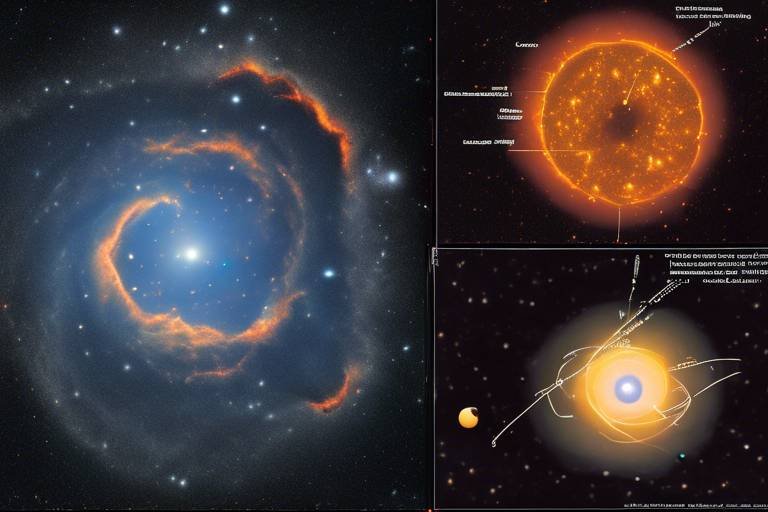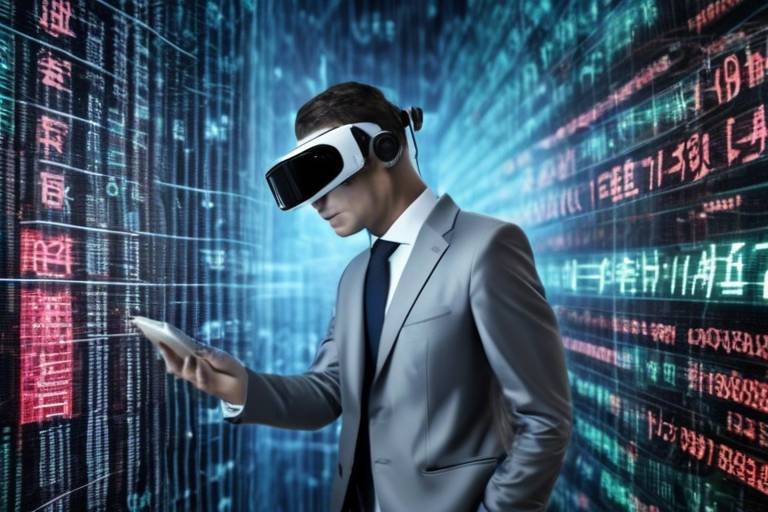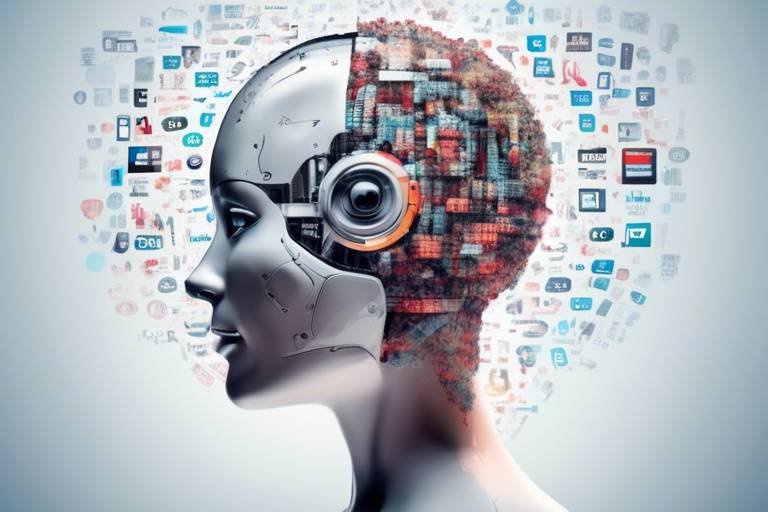AI in Astronomy: Your Guide to the Cosmos
Welcome to the fascinating intersection of artificial intelligence and astronomy! The universe is a vast and mysterious place, filled with countless celestial bodies, phenomena, and secrets waiting to be uncovered. With the advent of AI technology, our ability to explore and understand the cosmos has reached unprecedented levels. Imagine having a powerful assistant that can sift through enormous amounts of data, identify patterns, and even predict cosmic events with remarkable accuracy. That's exactly what AI is doing for astronomers today!
In this guide, we'll take you on a journey through the various ways AI is transforming our understanding of the universe. From enhancing data analysis capabilities to revolutionizing the search for exoplanets, AI is proving to be an indispensable tool for researchers. We'll also explore the challenges and limitations that come with integrating AI into astronomical research, shedding light on the road ahead.
Are you ready to dive into the cosmos and discover how AI is reshaping our view of the universe? Buckle up, because we're about to embark on an exciting adventure that combines cutting-edge technology with the timeless quest for knowledge!
One of the most significant contributions of AI in astronomy is its ability to process vast amounts of data. Traditional methods of data analysis can be slow and labor-intensive, often leaving researchers overwhelmed by the sheer volume of information generated by telescopes and other instruments. Enter AI, which significantly accelerates the processing of these astronomical datasets, enabling researchers to uncover patterns and anomalies that were previously undetectable.
AI techniques such as machine learning and deep learning are at the forefront of this revolution. By employing sophisticated algorithms, AI can identify trends and make predictions based on historical data. For instance, researchers can utilize AI to detect the faint signals of distant galaxies or pinpoint the exact moment a star goes supernova. The implications of this are staggering, as it allows astronomers to focus their efforts on the most promising leads, saving time and resources.
In the following sections, we will delve deeper into specific techniques and tools used in data analysis, showcasing the transformative power of AI in the field of astronomy.
Machine learning algorithms are pivotal in classifying celestial objects and predicting cosmic events. These algorithms learn from data, improving their accuracy over time. For instance, researchers can train models to recognize different types of stars, galaxies, and even exoplanets based on their unique characteristics. This not only speeds up the classification process but also enhances the reliability of the results.
Imagine trying to find a needle in a haystack. Now, imagine having a highly intelligent robot that can not only find the needle but also tell you everything about it! That's what machine learning does for astronomers. It helps them sift through the vast cosmic haystack, pinpointing the most relevant objects and events that warrant further investigation.
Neural networks are employed to analyze images from telescopes, identifying galaxies, stars, and other celestial bodies. By mimicking the way the human brain processes information, these networks can improve image classification and enhance astronomical surveys. For example, when researchers feed thousands of images into a neural network, the model learns to recognize patterns and features that distinguish different types of celestial objects.
Convolutional Neural Networks (CNNs) are particularly effective for processing visual data. Their architecture is designed to automatically detect and learn features from images, making them ideal for astronomical image analysis. By utilizing CNNs, astronomers can achieve more accurate classifications of galaxies and other celestial bodies, leading to better understanding and insights into the structure of the universe.
Generative Adversarial Networks (GANs) can create synthetic astronomical images, aiding in data augmentation and model training. These networks consist of two components: a generator that creates images and a discriminator that evaluates them. This unique capability allows researchers to enhance the quality of observational data, filling in gaps and improving the overall dataset available for analysis.
Predictive modeling using AI helps astronomers forecast events like supernovae and asteroid impacts. By analyzing past data and identifying patterns, AI can assist researchers in predicting when and where these events might occur. This is crucial for planning observational campaigns and ensuring that we are prepared for potential cosmic threats.
AI technologies are revolutionizing the search for exoplanets by analyzing light curves and other data sources. The quest to find new worlds beyond our solar system has been greatly enhanced by the integration of AI, leading to key breakthroughs and methodologies in the identification of exoplanets. With AI at the helm, astronomers can now sift through data from missions like Kepler and TESS more efficiently than ever before.
The transit method involves detecting dips in starlight caused by orbiting planets. AI enhances the accuracy and efficiency of this technique by quickly analyzing large datasets and identifying potential exoplanets with remarkable precision. This means that astronomers can discover new planets faster, opening up exciting possibilities for future research.
AI optimizes the radial velocity method by analyzing shifts in spectral lines. This traditional technique, which measures the gravitational influence of a planet on its host star, benefits immensely from AI's analytical capabilities. By improving the accuracy of these measurements, AI helps astronomers detect exoplanets that may have previously gone unnoticed.
Despite its potential, AI in astronomy faces challenges such as data quality, interpretability, and the need for large datasets. These limitations can hinder the effectiveness of AI models and must be addressed to unlock the full potential of this technology. For instance, astronomical data can be noisy and incomplete, posing challenges for AI models that rely on high-quality input.
Astronomical data can be noisy and incomplete, posing challenges for AI models. Researchers are tackling these data quality issues by developing advanced preprocessing techniques and utilizing more robust algorithms that can handle imperfect data. By improving the quality of the input data, AI can produce more reliable and accurate results.
Understanding how AI models arrive at conclusions is crucial in scientific research. The importance of interpretability cannot be overstated, as it enhances transparency and builds trust in AI applications in astronomy. Efforts are underway to develop methods that allow researchers to gain insights into the decision-making processes of AI models, ensuring that their findings can be understood and validated.
- What is AI's role in astronomy? AI helps process large datasets, classify celestial objects, and predict cosmic events, enhancing our understanding of the universe.
- How does machine learning benefit astronomical research? Machine learning algorithms improve classification accuracy and efficiency, allowing astronomers to focus on promising leads.
- What are some challenges AI faces in astronomy? Challenges include data quality issues, the need for large datasets, and the interpretability of AI models.

The Role of AI in Data Analysis
In the vast expanse of the universe, astronomers are faced with an overwhelming amount of data. Imagine sifting through millions of images and readings from telescopes, each containing vital information about celestial phenomena. This is where artificial intelligence (AI) steps in as a game changer. By leveraging advanced algorithms and machine learning techniques, AI significantly accelerates the processing of these vast astronomical datasets. It enables researchers to uncover patterns and anomalies that were previously undetectable, transforming the way we understand the cosmos.
One of the standout features of AI in data analysis is its ability to manage and analyze data at an unprecedented scale. Traditional methods of data analysis often fall short when it comes to handling the sheer volume of information generated by modern telescopes and space missions. AI tools, on the other hand, can process these datasets in a fraction of the time, allowing astronomers to focus on interpretation rather than data crunching.
For instance, consider the use of machine learning algorithms to identify and classify celestial objects. These algorithms can learn from existing data, continuously improving their accuracy as they encounter new information. This leads to faster and more reliable classifications of stars, galaxies, and other cosmic entities. Moreover, AI can detect subtle anomalies in data that might indicate the presence of new celestial bodies or phenomena, such as gravitational waves or dark matter.
To illustrate the impact of AI in data analysis, let's take a look at some of the key techniques and tools employed:
| Technique | Description |
|---|---|
| Clustering Algorithms | Group similar data points to identify patterns in celestial objects. |
| Classification Models | Assign labels to data based on learned features, improving object recognition. |
| Anomaly Detection | Identify unusual data points that may indicate new discoveries. |
| Time Series Analysis | Analyze data over time to detect changes and predict future events. |
Furthermore, AI doesn't just stop at analyzing existing data; it also plays a crucial role in data augmentation. By generating synthetic datasets that mimic real astronomical data, AI can help researchers train their models more effectively. This is particularly useful in situations where data is scarce or incomplete, allowing for a more robust analysis.
However, the integration of AI in data analysis is not without its challenges. The quality of astronomical data can often be noisy or incomplete, which can lead to inaccuracies in AI models. Researchers are actively working on methods to enhance data quality, such as using advanced filtering techniques and combining datasets from multiple sources to improve reliability.
In conclusion, the role of AI in data analysis is transforming the field of astronomy. By accelerating data processing, enhancing pattern recognition, and improving the quality of analyses, AI is not just a tool; it's a revolutionary force that is pushing the boundaries of our understanding of the universe. As we continue to explore the cosmos, the importance of AI in data analysis will only grow, paving the way for groundbreaking discoveries that were once thought to be beyond our reach.
- How does AI improve data analysis in astronomy? AI accelerates data processing, enhances pattern recognition, and helps identify anomalies in large datasets.
- What types of algorithms are commonly used in astronomical data analysis? Common algorithms include clustering algorithms, classification models, anomaly detection, and time series analysis.
- What challenges does AI face in astronomical data analysis? Challenges include data quality issues, interpretability of AI models, and the need for large, high-quality datasets.

Machine Learning Techniques in Astronomy
Machine learning is a game-changer in the field of astronomy, offering innovative solutions to complex problems that have long challenged astronomers. With the vastness of the universe comes a staggering amount of data, and traditional methods of analysis simply can't keep up. This is where machine learning steps in, acting like a supercharged assistant that can sift through mountains of information, uncovering patterns and making predictions that would otherwise remain hidden. Imagine trying to find a needle in a haystack; now, picture having a magnet that not only finds the needle but also identifies its type and origin. That's the power of machine learning in astronomy!
One of the most exciting aspects of machine learning in this field is its ability to classify celestial objects with incredible accuracy. For instance, researchers employ various machine learning models, such as decision trees, support vector machines, and neural networks, to categorize stars, galaxies, and other astronomical phenomena. These models learn from existing datasets, continuously improving their accuracy as they process more information. The result? A more efficient classification system that can handle the overwhelming influx of astronomical data.
Moreover, machine learning algorithms can predict cosmic events, such as the likelihood of supernovae or the trajectory of asteroids heading towards Earth. By analyzing historical data and recognizing patterns, these algorithms can provide valuable insights that help astronomers prepare for and understand these events better. It's like having a crystal ball that not only shows you the future but also explains the science behind it!
When it comes to analyzing images captured by telescopes, neural networks are at the forefront of the revolution. These sophisticated algorithms can process and analyze images to identify celestial bodies such as galaxies, stars, and even distant planets. The beauty of neural networks lies in their ability to improve image classification over time. As they are exposed to more data, they learn and adapt, becoming increasingly adept at recognizing subtle differences between objects.
Among the various types of neural networks, Convolutional Neural Networks (CNNs) are particularly effective for visual data processing. CNNs mimic the way human brains process visual information, making them ideal for tasks such as identifying features in astronomical images. Their architecture includes layers that automatically detect and learn features like edges, shapes, and textures, which are crucial for accurate image classification. This means that astronomers can analyze images with unprecedented precision, leading to more accurate surveys and discoveries.
Generative Adversarial Networks (GANs) are another exciting innovation in machine learning, capable of creating synthetic astronomical images. This capability is particularly useful for data augmentation, where GANs generate additional training data that enhances the performance of machine learning models. By producing high-quality synthetic images, GANs help improve observational data quality, making it easier for astronomers to train their models and achieve better results. Think of GANs as the artists of the astronomical world, painting new pictures based on the data they’ve learned from existing images.
Predictive modeling using AI techniques allows astronomers to forecast cosmic events with remarkable accuracy. By analyzing various data sources, such as light curves and spectral data, machine learning algorithms can predict phenomena like supernovae and asteroid impacts. This predictive capability is crucial, as it helps researchers understand the potential risks and prepare for future events. It's like having a weather forecast for the universe—allowing astronomers to anticipate changes and make informed decisions based on data-driven predictions.
In conclusion, the integration of machine learning in astronomy is not just a trend; it's a transformative approach that empowers researchers to explore the cosmos in ways previously thought impossible. As technology continues to evolve, we can expect even more groundbreaking applications of machine learning that will deepen our understanding of the universe and expand our horizons.
- What is machine learning in astronomy? - Machine learning in astronomy refers to the use of algorithms and statistical models to analyze large datasets, classify celestial objects, and predict cosmic events.
- How do neural networks work in astronomy? - Neural networks analyze images and data to identify patterns and classify celestial objects, improving their accuracy as they learn from more data.
- What are GANs and how are they used in astronomy? - Generative Adversarial Networks (GANs) are used to create synthetic astronomical images, aiding in data augmentation and improving the quality of observational data.
- Can machine learning predict cosmic events? - Yes, machine learning can analyze historical data to predict events like supernovae and asteroid impacts, helping astronomers prepare for future occurrences.

Neural Networks for Image Recognition
Neural networks have emerged as a game-changer in the realm of astronomy, particularly when it comes to image recognition. Imagine standing before a vast, starry sky and trying to identify distinct celestial bodies amidst a sea of twinkling lights. This task, once daunting for astronomers, has been revolutionized by the power of artificial intelligence. Neural networks, a subset of machine learning, mimic the way human brains process information, allowing them to analyze complex datasets and recognize patterns with astonishing accuracy.
One of the primary applications of neural networks in astronomy is the analysis of images captured by powerful telescopes. These images often contain a wealth of information, from the luminous glow of distant galaxies to the subtle features of nearby stars. However, the sheer volume of data can be overwhelming. Here’s where neural networks come into play. By training these networks on vast datasets, astronomers can automate the classification of celestial objects, drastically reducing the time and effort required for manual analysis.
Neural networks utilize various architectures, but the most prominent among them for image recognition tasks are Convolutional Neural Networks (CNNs). CNNs are specifically designed to process visual data, making them ideal for handling astronomical images. They work by applying multiple layers of filters to the input data, allowing the network to learn hierarchical features. For instance, in the initial layers, the CNN might learn to recognize simple shapes, while deeper layers can identify more complex structures, such as the spiral arms of a galaxy or the intricate patterns of a nebula.
To illustrate the impact of neural networks on image recognition in astronomy, consider the following table that summarizes key advancements:
| Advancement | Description | Impact on Astronomy |
|---|---|---|
| Automated Classification | Neural networks can classify celestial objects based on their features. | Reduces manual workload and increases efficiency in data analysis. |
| Enhanced Image Quality | Networks can improve image resolution and clarity. | Allows for better observation and understanding of celestial phenomena. |
| Pattern Recognition | Identifies anomalies and unique features in astronomical data. | Facilitates the discovery of new celestial objects and events. |
Moreover, the ability of neural networks to learn from data means that they can continuously improve over time. As new images and data become available, these networks can be retrained to refine their accuracy further. This adaptability is crucial in a field where new discoveries are made regularly, and the landscape of the cosmos is ever-changing.
However, it's important to note that while neural networks have significantly improved the efficiency of image recognition in astronomy, they are not without their challenges. Issues such as data quality and the need for large, labeled datasets can hinder their performance. Astronomers must ensure that the data fed into these networks is as clean and representative as possible to achieve reliable results.
In summary, neural networks are transforming how astronomers analyze images of the cosmos. By leveraging the capabilities of these advanced algorithms, researchers can not only identify celestial objects more efficiently but also gain deeper insights into the universe's mysteries. The future of astronomy is undoubtedly intertwined with the advancements in AI, and neural networks are at the forefront of this exciting journey.
- What are neural networks? Neural networks are computational models inspired by the human brain, designed to recognize patterns and make predictions based on data.
- How do neural networks improve image recognition in astronomy? They automate the classification of celestial objects, enhance image quality, and identify patterns that might be missed by human analysts.
- What challenges do neural networks face in astronomy? Challenges include data quality issues, the need for large datasets, and the interpretability of AI models.

Convolutional Neural Networks (CNNs)
Convolutional Neural Networks, or CNNs, have revolutionized the way we process and analyze astronomical images. These specialized neural networks are designed to automatically and adaptively learn spatial hierarchies of features from images, making them particularly effective for tasks like identifying celestial bodies in telescope images. Imagine trying to find a needle in a haystack; CNNs act like a magnet, drawing out the important features from a massive dataset of images while filtering out the noise.
At the core of CNNs is their ability to utilize convolutional layers, which apply a series of filters to the input image. Each filter is trained to recognize specific patterns, such as edges, textures, or more complex shapes. As the data passes through multiple layers, the network builds a comprehensive understanding of the image, enabling it to classify or detect objects with remarkable precision. This process is akin to peeling an onion, where each layer reveals deeper insights into the structure of the data.
One of the standout features of CNNs is their capacity for transfer learning. This technique allows astronomers to take a pre-trained CNN model—originally developed for a different task—and fine-tune it for astronomical applications. For example, a CNN trained on everyday images can be adapted to identify galaxies, stars, and other celestial phenomena, significantly reducing the time and computational resources needed for training from scratch. This adaptability is crucial in astronomy, where datasets can be vast and diverse.
Moreover, CNNs have shown impressive results in various astronomical projects, including:
- Identifying and classifying galaxies based on their shapes.
- Detecting supernovae in real-time data streams.
- Enhancing images captured by telescopes, making it easier to spot faint objects.
However, CNNs are not without their challenges. One significant hurdle is the need for large labeled datasets to train the models effectively. In astronomy, acquiring such datasets can be time-consuming and expensive. Researchers are actively working on solutions, such as generating synthetic data through methods like Generative Adversarial Networks (GANs), which can supplement real data and improve the training process.
In conclusion, Convolutional Neural Networks are a powerful tool in the realm of astronomy, providing researchers with enhanced capabilities to analyze and interpret vast amounts of image data. As technology continues to advance, the potential applications of CNNs in discovering new celestial phenomena and understanding the universe will only grow, opening up exciting possibilities for future research.
Q1: What are Convolutional Neural Networks used for in astronomy?
A1: CNNs are primarily used for image classification, object detection, and enhancing image quality in astronomical research. They help identify and classify celestial objects like galaxies and stars from telescope images.
Q2: How do CNNs improve the accuracy of astronomical data analysis?
A2: By automatically learning and extracting features from images, CNNs can identify patterns and anomalies that might be missed by traditional analysis methods, leading to more accurate classifications and discoveries.
Q3: What is transfer learning, and why is it important for CNNs in astronomy?
A3: Transfer learning allows a pre-trained CNN model to be adapted for a new task, reducing the need for extensive training data. This is particularly beneficial in astronomy, where labeled datasets can be scarce.
Q4: Are there any limitations to using CNNs in astronomy?
A4: Yes, CNNs require large amounts of labeled data for effective training, and obtaining such datasets in astronomy can be challenging. Additionally, interpretability of CNNs can be an issue, making it hard to understand how they arrive at certain conclusions.

Generative Adversarial Networks (GANs)
Generative Adversarial Networks, commonly known as GANs, have emerged as a groundbreaking tool in the realm of astronomy. At their core, GANs consist of two neural networks: a generator and a discriminator, which work in a competitive setting. The generator creates synthetic data, while the discriminator evaluates its authenticity. This unique interplay allows GANs to produce remarkably realistic astronomical images, which can be invaluable for various research applications.
One of the primary advantages of using GANs in astronomy is their ability to enhance data augmentation. In many cases, astronomers deal with limited datasets, which can hinder the training of robust machine learning models. By generating synthetic images, GANs effectively expand the dataset, allowing researchers to train models more effectively. This is particularly useful in fields like supernova detection and galaxy classification, where high-quality images are essential for accurate analysis.
Moreover, GANs play a crucial role in improving the quality of observational data. For instance, they can help reduce noise in images captured by telescopes, making it easier to identify faint celestial objects. By training GANs on existing noisy images, researchers can generate cleaner versions that preserve essential features while eliminating unwanted artifacts. This process not only enhances the clarity of the data but also facilitates a more accurate interpretation of astronomical phenomena.
To illustrate the impact of GANs on astronomical research, consider the following table that summarizes their key contributions:
| Application | Contribution of GANs |
|---|---|
| Data Augmentation | Generates synthetic images to expand limited datasets |
| Noise Reduction | Creates cleaner images from noisy observational data |
| Model Training | Enhances training of machine learning models with more diverse data |
| Simulation of Cosmic Events | Produces realistic simulations for training and testing purposes |
Despite their numerous advantages, GANs are not without challenges. For instance, the training process can be computationally intensive, requiring significant resources and time. Additionally, ensuring the generated data accurately reflects real-world scenarios can be tricky, as GANs might produce artifacts that do not exist in actual astronomical images. Researchers are actively working on refining GAN architectures and training methodologies to address these issues, paving the way for more reliable applications in astronomy.
In conclusion, Generative Adversarial Networks are revolutionizing the way astronomers analyze and interpret data. Their ability to generate synthetic images and enhance existing datasets is proving to be a game-changer in the field, unlocking new possibilities for research and discovery. As advancements in GAN technology continue, we can expect even more exciting developments in our quest to understand the universe.

Predictive Modeling for Cosmic Events
Predictive modeling in astronomy is like having a crystal ball that allows scientists to foresee cosmic events before they happen. Imagine being able to predict the next big supernova or the trajectory of an asteroid that could potentially impact Earth. With the power of artificial intelligence (AI), this dream is becoming a reality. AI algorithms analyze vast amounts of data, identifying patterns and trends that human researchers might overlook. By leveraging these advanced techniques, astronomers can create predictive models that not only enhance our understanding of the universe but also help in making informed decisions regarding planetary defense and resource allocation for future space missions.
One of the most exciting aspects of predictive modeling is its application in forecasting supernovae. When a massive star reaches the end of its life cycle, it can explode in a spectacular display of energy and light. AI models are trained on historical data from previous supernovae, learning to recognize the subtle signals that precede such events. This process involves analyzing various factors, such as the star's luminosity, temperature, and chemical composition. The outcome? A more accurate prediction of when and where a supernova might occur, giving astronomers a chance to observe these celestial fireworks in real-time.
Another critical application of predictive modeling is in tracking near-Earth objects (NEOs). These include asteroids and comets that come close to our planet. Using AI, researchers can analyze the orbits of these objects, predicting their future positions with remarkable precision. For instance, by examining past trajectories and gravitational influences from other celestial bodies, AI algorithms can forecast potential impacts, allowing for timely warnings and mitigation strategies. This is crucial, as even a small asteroid could cause significant damage if it were to collide with Earth.
Moreover, the methodologies behind these predictive models are continually evolving. Researchers are combining traditional statistical methods with machine learning techniques to enhance the reliability of their predictions. For example, ensemble methods, which involve using multiple models to make predictions, can lead to more robust outcomes. By aggregating results from various algorithms, scientists can minimize the risk of false positives and improve the overall accuracy of their forecasts.
However, the journey of predictive modeling isn't without its challenges. One major hurdle is the quality of the data being used. Astronomical data can often be noisy, incomplete, or subject to various biases. To overcome this, researchers are developing sophisticated data-cleaning techniques and augmenting their datasets with synthetic data generated by AI. This ensures that the models are trained on high-quality information, ultimately leading to better predictions.
In conclusion, predictive modeling for cosmic events is transforming the field of astronomy. With AI at the helm, we are not only enhancing our understanding of celestial phenomena but also equipping ourselves with the tools needed to protect our planet from potential cosmic threats. As technology continues to advance, the possibilities for predictive modeling in astronomy are boundless, promising a future where we can gaze into the cosmos with greater confidence.
- What is predictive modeling in astronomy? Predictive modeling involves using algorithms to analyze astronomical data to forecast future cosmic events, such as supernovae or asteroid impacts.
- How does AI improve predictive modeling? AI enhances predictive modeling by analyzing vast datasets, identifying patterns, and making accurate predictions based on historical trends.
- What challenges does predictive modeling face? Challenges include data quality issues, the complexity of celestial phenomena, and the need for large datasets to train AI models effectively.
- Can predictive modeling prevent asteroid impacts? While it cannot prevent impacts, predictive modeling can provide early warnings, allowing for potential mitigation strategies to be developed.

AI in Exoplanet Discovery
Artificial intelligence is making waves in the field of exoplanet discovery, a domain that has long fascinated astronomers and space enthusiasts alike. With the universe teeming with billions of stars, each potentially hosting its own planetary system, the challenge lies in sifting through the immense amount of data to identify these distant worlds. AI technologies are stepping in to revolutionize this search, making it faster, more accurate, and more efficient than ever before.
One of the most significant breakthroughs in exoplanet discovery comes from the analysis of light curves—graphs that depict the brightness of stars over time. When a planet passes in front of a star, it causes a temporary dip in brightness, which can be detected and measured. Traditionally, this process was labor-intensive and required meticulous manual analysis. However, AI algorithms, particularly those based on machine learning, can now automate this process, identifying patterns and anomalies that would otherwise go unnoticed.
For instance, researchers have developed sophisticated models that utilize neural networks to analyze vast datasets from missions like Kepler and TESS (Transiting Exoplanet Survey Satellite). These models can quickly classify light curves and flag potential exoplanet candidates for further study. This not only accelerates the discovery process but also increases the likelihood of identifying planets that may have been missed by human analysis.
In addition to light curves, AI is also enhancing the effectiveness of the radial velocity method. This technique involves measuring the tiny shifts in a star's spectral lines caused by the gravitational pull of an orbiting planet. AI algorithms can analyze these shifts with greater precision, allowing astronomers to detect smaller planets and those further from their stars. By optimizing the data processing, AI helps to refine the measurements, making it easier to confirm the presence of new exoplanets.
Here's a quick overview of how AI is transforming the search for exoplanets:
| Method | AI Contribution | Impact |
|---|---|---|
| Transit Method | Automated light curve analysis | Faster identification of candidates |
| Radial Velocity Method | Enhanced spectral line analysis | Detection of smaller and distant planets |
As we look to the future, the integration of AI in exoplanet discovery holds immense promise. The ability to process vast amounts of data quickly and accurately means that we are likely to discover a plethora of new worlds in the coming years. Imagine the excitement of finding a new Earth-like planet, potentially harboring life, simply because AI could sift through data more efficiently than ever before!
However, it's important to note that while AI is a powerful tool, it is not without its challenges. The quality of data fed into AI models can significantly affect their performance. Noisy or incomplete datasets can lead to inaccurate predictions, which is why researchers are continually working to improve data collection methods. Additionally, transparency in how AI models operate is crucial for scientific integrity, ensuring that findings can be trusted and validated by the broader scientific community.
In conclusion, AI is not just a buzzword in astronomy; it is a transformative force that is reshaping how we discover and understand exoplanets. As technology continues to evolve, we can only imagine the wonders that await us in our quest to explore the cosmos.
- What is an exoplanet? An exoplanet is a planet that orbits a star outside our solar system.
- How does AI help in finding exoplanets? AI analyzes astronomical data, automating the detection of patterns that indicate the presence of exoplanets.
- What are the main methods for discovering exoplanets? The two primary methods are the transit method and the radial velocity method.
- Are there any limitations to using AI in astronomy? Yes, challenges include data quality issues and the need for interpretability of AI models.

Transit Method Analysis
The transit method is one of the most exciting techniques astronomers use to discover exoplanets. Imagine peering through a cosmic window, where the light from distant stars flickers as planets pass in front of them. This method detects the subtle dips in starlight caused by a planet's transit across its host star. As these celestial bodies move in their orbits, they momentarily block a fraction of the star's light, creating a telltale signature that AI can help us analyze more effectively than ever before.
With the vast amount of data collected from space telescopes like Kepler and TESS (Transiting Exoplanet Survey Satellite), astronomers face the daunting task of sifting through millions of light curves. This is where artificial intelligence steps in, acting like a supercharged assistant that can identify patterns and anomalies faster than any human could. By employing advanced algorithms, AI can process these light curves to pinpoint potential exoplanets with remarkable precision.
One of the key advantages of using AI in transit method analysis is its ability to reduce false positives. Traditional methods often led to misidentifications due to noise or other astrophysical phenomena, such as eclipsing binaries. AI algorithms can learn from vast datasets, distinguishing between genuine planetary transits and other stellar variations. This is crucial because the universe is filled with complex interactions, and every dip in starlight doesn't necessarily indicate a new world.
Furthermore, AI enhances the efficiency of the transit method by automating the detection process. Instead of manually analyzing each light curve, researchers can now rely on machine learning models to flag potential candidates for further examination. This not only speeds up the discovery process but also allows astronomers to focus their efforts on the most promising leads. To illustrate this, consider the following table that highlights the differences between traditional methods and AI-enhanced techniques:
| Aspect | Traditional Methods | AI-Enhanced Methods |
|---|---|---|
| Speed of Analysis | Slow, manual processing | Fast, automated detection |
| False Positive Rate | Higher due to noise | Lower, more accurate identification |
| Data Handling | Limited by human capacity | Scalable to massive datasets |
Moreover, AI's capability to analyze multi-dimensional data opens new doors for understanding the characteristics of these exoplanets. For example, by combining transit data with other observational techniques, such as radial velocity measurements, AI can provide a more comprehensive picture of a planet's size, mass, and even atmospheric composition. This holistic approach is invaluable for determining the habitability of these distant worlds.
In summary, the transit method analysis exemplifies how AI is revolutionizing the search for exoplanets. By enhancing the accuracy and efficiency of this technique, AI not only accelerates the discovery of new worlds but also enriches our understanding of the universe. As we continue to refine these technologies, who knows what astonishing discoveries await us in the cosmos?
- What is the transit method? The transit method detects exoplanets by observing dips in starlight when a planet passes in front of its host star.
- How does AI improve the transit method? AI enhances the efficiency and accuracy of data analysis, reducing false positives and automating the detection process.
- What are some tools used in transit method analysis? Space telescopes like Kepler and TESS are crucial tools, along with machine learning algorithms for data processing.
- Can AI help in discovering habitable exoplanets? Yes, AI can analyze various data to assess the characteristics of exoplanets, including their potential for habitability.

Radial Velocity Method Improvements
The radial velocity method has long been a cornerstone in the search for exoplanets. By measuring the shifts in spectral lines of stars caused by the gravitational pull of orbiting planets, astronomers have been able to infer the presence of these distant worlds. However, traditional methods often faced limitations in sensitivity and accuracy, particularly when detecting smaller planets or those that are farther from their host stars. Fortunately, advancements in artificial intelligence (AI) have ushered in a new era of precision in this field.
AI techniques, particularly machine learning algorithms, have been instrumental in refining the radial velocity method. By analyzing extensive datasets and identifying subtle patterns, AI can enhance the detection of radial velocity signals that might otherwise be overlooked. For instance, researchers have developed AI models that can automatically filter out noise from observational data, isolating genuine signals of planetary presence. This capability is crucial, as the noise in astronomical data can often mask the faint signals that indicate a planet's existence.
Additionally, AI can improve the interpretation of spectral data. By employing advanced algorithms, astronomers can now model the complex interactions between light and matter more effectively. This enhancement not only increases the accuracy of measurements but also provides a more comprehensive understanding of the physical characteristics of the detected exoplanets. For example, AI can help distinguish between signals caused by planets and those caused by stellar activity, leading to more reliable conclusions.
Moreover, the integration of AI in the radial velocity method allows for the development of predictive models that can forecast the likelihood of detecting new exoplanets based on existing data. This predictive capability can significantly streamline the research process, allowing astronomers to focus on the most promising targets. With AI at the helm, the efficiency of data analysis has drastically improved, enabling quicker turnaround times in the identification of new worlds.
To illustrate the impact of AI on the radial velocity method, consider the following table that summarizes key improvements:
| Improvement | Description |
|---|---|
| Noise Reduction | AI algorithms filter out noise from data, enhancing the clarity of planetary signals. |
| Enhanced Accuracy | Improved modeling of spectral data leads to more precise measurements of planetary characteristics. |
| Predictive Modeling | AI can forecast the likelihood of finding new exoplanets based on existing datasets. |
In conclusion, the incorporation of AI into the radial velocity method represents a significant leap forward in the quest to discover exoplanets. As we continue to refine these technologies, the possibilities for uncovering new worlds become even more exciting. With AI's ability to analyze and interpret complex data, the universe may soon reveal many more of its hidden treasures.
- What is the radial velocity method? The radial velocity method detects exoplanets by measuring the shifts in spectral lines of stars caused by the gravitational influence of orbiting planets.
- How does AI improve the radial velocity method? AI enhances the method by filtering out noise, improving data interpretation, and providing predictive models for identifying potential exoplanets.
- What are the challenges faced in the radial velocity method? Challenges include noise in data, distinguishing between planetary signals and stellar activity, and the need for precise measurements.

Challenges and Limitations of AI in Astronomy
While the integration of artificial intelligence (AI) into astronomy has opened up a universe of possibilities, it is not without its challenges and limitations. One of the most pressing issues is the quality of astronomical data. Data collected from telescopes can often be noisy, incomplete, or affected by various observational biases. This can pose significant hurdles for AI models that rely on high-quality data to make accurate predictions or classifications. Researchers are actively seeking methods to enhance data quality, such as employing advanced noise reduction techniques or utilizing data augmentation strategies to create more robust datasets.
Another significant challenge lies in the interpretability of AI models. In scientific research, understanding how a model arrives at its conclusions is crucial. This is particularly important in astronomy, where misinterpretations could lead to incorrect assumptions about celestial phenomena. Currently, many AI models, especially deep learning algorithms, operate as "black boxes," making it difficult for astronomers to understand the rationale behind their predictions. Efforts are underway to improve the transparency of these models, with researchers exploring techniques like explainable AI (XAI) to shed light on the decision-making processes of AI systems.
Furthermore, the effectiveness of AI in astronomy often hinges on the availability of large datasets. Many traditional astronomical datasets are limited in size, which can impede the performance of machine learning algorithms. To address this, astronomers are increasingly collaborating with other scientific fields to share data and create comprehensive databases. For instance, the integration of data from various observatories and missions can significantly enrich the datasets available for AI training.
In summary, while AI holds tremendous potential to revolutionize astronomy, several challenges must be addressed. These include:
- Data Quality: Noisy and incomplete data can lead to inaccurate AI outcomes.
- Interpretability: The need for transparency in AI decision-making processes is critical.
- Data Availability: Large and diverse datasets are essential for effective AI training.
Researchers continue to innovate and find solutions to these challenges, paving the way for a future where AI can unlock even more secrets of the cosmos. The journey is ongoing, and as we learn more about the universe, the role of AI will undoubtedly evolve, presenting new opportunities and challenges along the way.
Q1: What are the main challenges AI faces in astronomy?
A1: The main challenges include data quality issues, the interpretability of AI models, and the need for large datasets for training AI algorithms.
Q2: How does data quality affect AI outcomes?
A2: Noisy or incomplete data can lead to inaccurate predictions and classifications, making it crucial to enhance data quality for better AI performance.
Q3: Why is interpretability important in AI applications?
A3: Interpretability is vital for understanding how AI models make decisions, which is essential in scientific research to avoid misinterpretations of astronomical phenomena.
Q4: What is explainable AI (XAI)?
A4: Explainable AI refers to methods and techniques that make the outputs of AI models more understandable to humans, enhancing transparency and trust in AI applications.

Data Quality Issues
In the vast realm of astronomy, the quality of data is paramount. Astronomical observations often come from a myriad of sources, including ground-based telescopes and space missions, each with its own set of challenges. These challenges can lead to that significantly affect the performance of AI models. For instance, the data collected may be noisy due to atmospheric interference, or it could be incomplete because of equipment malfunctions or limitations in observational time. Such factors can obscure the true signals we are trying to analyze, making it difficult for AI systems to learn effectively.
One of the most pressing issues is the presence of noise in the data. Noise can arise from various sources, including cosmic rays, thermal fluctuations, and even the instruments themselves. This noise can mask the subtle signals that AI is designed to detect, leading to false positives or missed detections. To combat this, researchers are developing advanced filtering techniques that enhance the quality of the data before it is fed into AI algorithms. For example, machine learning techniques can be employed to distinguish between noise and actual astronomical signals, improving the overall integrity of the dataset.
Moreover, the completeness of the data is another critical concern. Incomplete datasets can arise when certain celestial events are not captured due to observational constraints or when data from specific wavelengths is missing. This lack of comprehensive data can skew the results of AI analyses, leading to inaccurate conclusions. As a solution, astronomers are increasingly turning to data augmentation techniques, which involve simulating additional data points based on existing information. This approach not only fills in the gaps but also provides AI models with a more robust training foundation.
Another aspect to consider is the variability of astronomical phenomena. For instance, certain stars may exhibit changes in brightness over time, which can complicate data interpretation. AI models must be trained to recognize and account for these variations, ensuring that they do not misclassify transient events as permanent features. This requires a nuanced understanding of the underlying physics and the incorporation of temporal data into the AI training process.
In summary, addressing data quality issues is crucial for the successful application of AI in astronomy. By implementing advanced filtering techniques, ensuring dataset completeness, and accounting for variability, researchers can enhance the fidelity of astronomical data. This, in turn, allows AI systems to operate more effectively, leading to groundbreaking discoveries in our understanding of the cosmos. As we continue to refine these methods, the potential for AI to revolutionize astronomy remains boundless.
- What are the main sources of data quality issues in astronomy? Data quality issues can arise from noise, incomplete datasets, and variability in astronomical phenomena.
- How does AI help in improving data quality? AI can employ advanced filtering techniques and data augmentation methods to enhance the integrity and completeness of astronomical datasets.
- Why is data quality important for AI in astronomy? High-quality data is essential for training AI models accurately, which directly affects the reliability of the results and discoveries made in astronomical research.

Interpretability of AI Models
In the realm of astronomy, the use of artificial intelligence (AI) has opened up new frontiers in research and discovery. However, as we dive deeper into this technological revolution, one critical aspect cannot be overlooked: the . Simply put, interpretability refers to the degree to which a human can understand the cause of a decision made by an AI system. In a field as intricate as astronomy, where the stakes are high and the data is complex, ensuring that AI models are interpretable is not just beneficial—it’s essential.
Imagine being on a spaceship, navigating through an uncharted galaxy. You’d want to understand how the navigation system is making decisions about your course, right? The same logic applies to AI models in astronomy. Researchers need to trust that the AI's predictions and classifications are based on sound reasoning. Without this trust, the potential of AI in unraveling cosmic mysteries could be severely hampered.
One of the primary challenges in achieving interpretability lies in the inherent complexity of many AI models, especially deep learning algorithms. These models often function as "black boxes," where inputs go in, and outputs come out, but the inner workings remain obscured. To combat this, astronomers and data scientists are employing several strategies to enhance interpretability:
- Visualization Techniques: By employing advanced visualization methods, researchers can gain insights into how different features of astronomical data influence the AI's decisions.
- Feature Importance Analysis: This technique helps identify which features of the input data are most influential in the model's predictions, thereby shedding light on the decision-making process.
- Explainable AI (XAI) Frameworks: These frameworks are designed to make AI outputs more understandable by providing explanations that are accessible to non-experts.
Furthermore, the importance of interpretability extends beyond just understanding the AI's decisions. It plays a crucial role in the scientific method itself. Astronomy, as a discipline, thrives on evidence-based conclusions. If an AI model identifies a new celestial object or predicts an astronomical event, scientists must be able to scrutinize the model's reasoning. This scrutiny not only validates the AI's findings but also ensures that the scientific community can build upon these discoveries with confidence.
Moreover, as AI continues to evolve, the demand for transparency in its applications will only grow. Funding agencies and institutions are increasingly emphasizing the need for clear and interpretable models, especially when public resources are involved. This trend is encouraging researchers to prioritize interpretability in their work, fostering a culture of accountability and trust within the scientific community.
In conclusion, while AI holds immense potential to revolutionize our understanding of the universe, the interpretability of these models is a non-negotiable aspect of their application in astronomy. By striving for transparency and clarity, we can ensure that the discoveries made through AI are not only groundbreaking but also credible and scientifically robust.
- What is interpretability in AI? Interpretability refers to how well a human can understand the reasons behind the decisions made by an AI model.
- Why is interpretability important in astronomy? It ensures that researchers can trust AI predictions and understand the reasoning behind them, which is crucial for scientific validation.
- What are some methods to improve AI interpretability? Techniques include visualization, feature importance analysis, and using explainable AI frameworks.
- How does interpretability impact scientific research? It fosters trust in AI findings, allowing scientists to build upon discoveries confidently.
Frequently Asked Questions (The title must be written in English.)
- What role does AI play in data analysis for astronomy?
AI plays a crucial role in data analysis by rapidly processing enormous datasets, allowing astronomers to identify patterns and anomalies that would be impossible to detect manually. This capability enables researchers to make groundbreaking discoveries and enhances the efficiency of astronomical research.
- How do machine learning techniques help in classifying celestial objects?
Machine learning techniques, particularly algorithms like neural networks, are instrumental in classifying celestial objects. These algorithms can learn from vast amounts of data, improving their accuracy over time and helping astronomers categorize galaxies, stars, and other cosmic entities with remarkable precision.
- What are Convolutional Neural Networks (CNNs) and how are they used in astronomy?
Convolutional Neural Networks (CNNs) are specialized neural networks designed to process visual data. In astronomy, they are employed to analyze images captured by telescopes, enhancing the classification of celestial objects and significantly improving the quality of astronomical surveys.
- Can AI predict cosmic events like supernovae or asteroid impacts?
Yes, AI can predict cosmic events such as supernovae and asteroid impacts through predictive modeling. By analyzing historical data and recognizing patterns, AI helps astronomers forecast these events, which is crucial for understanding cosmic phenomena and preparing for potential threats.
- How has AI transformed the search for exoplanets?
AI has revolutionized the search for exoplanets by efficiently analyzing light curves and other data sources. Techniques like the transit method have become more accurate with AI, enabling astronomers to discover new worlds with greater efficiency and reliability.
- What challenges does AI face in astronomy?
AI faces several challenges in astronomy, including data quality issues, the need for large datasets, and the interpretability of AI models. Researchers are actively working on solutions to improve data quality and enhance the transparency of AI processes to ensure reliable outcomes.
- Why is the interpretability of AI models important in astronomy?
Interpretability is vital because it allows scientists to understand how AI models arrive at their conclusions. This transparency is essential for building trust in AI applications and ensuring that the findings can be validated and used effectively in scientific research.



















